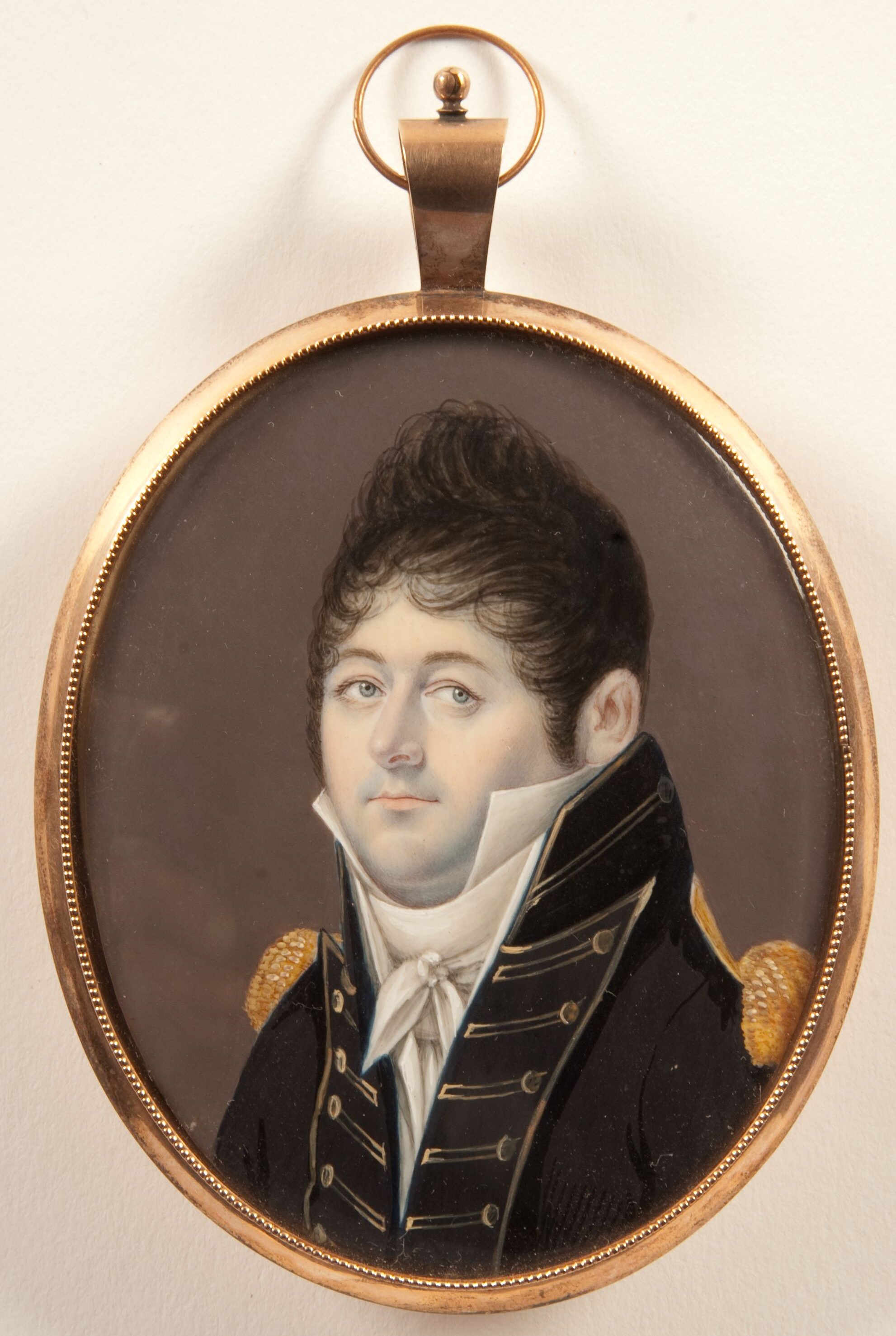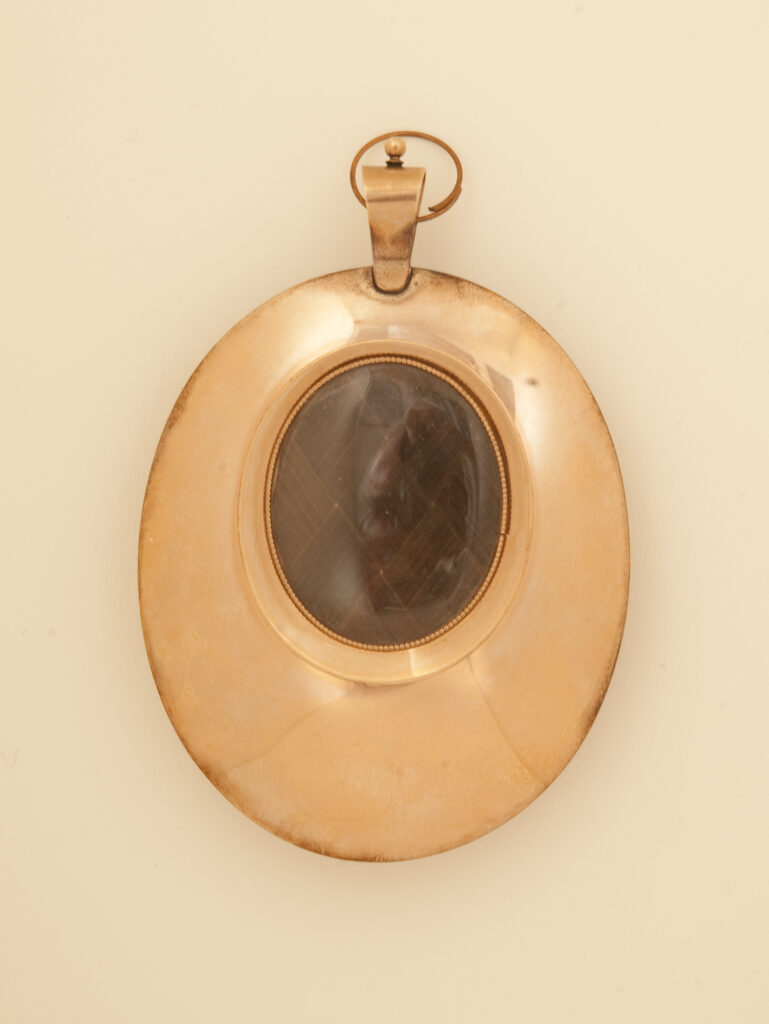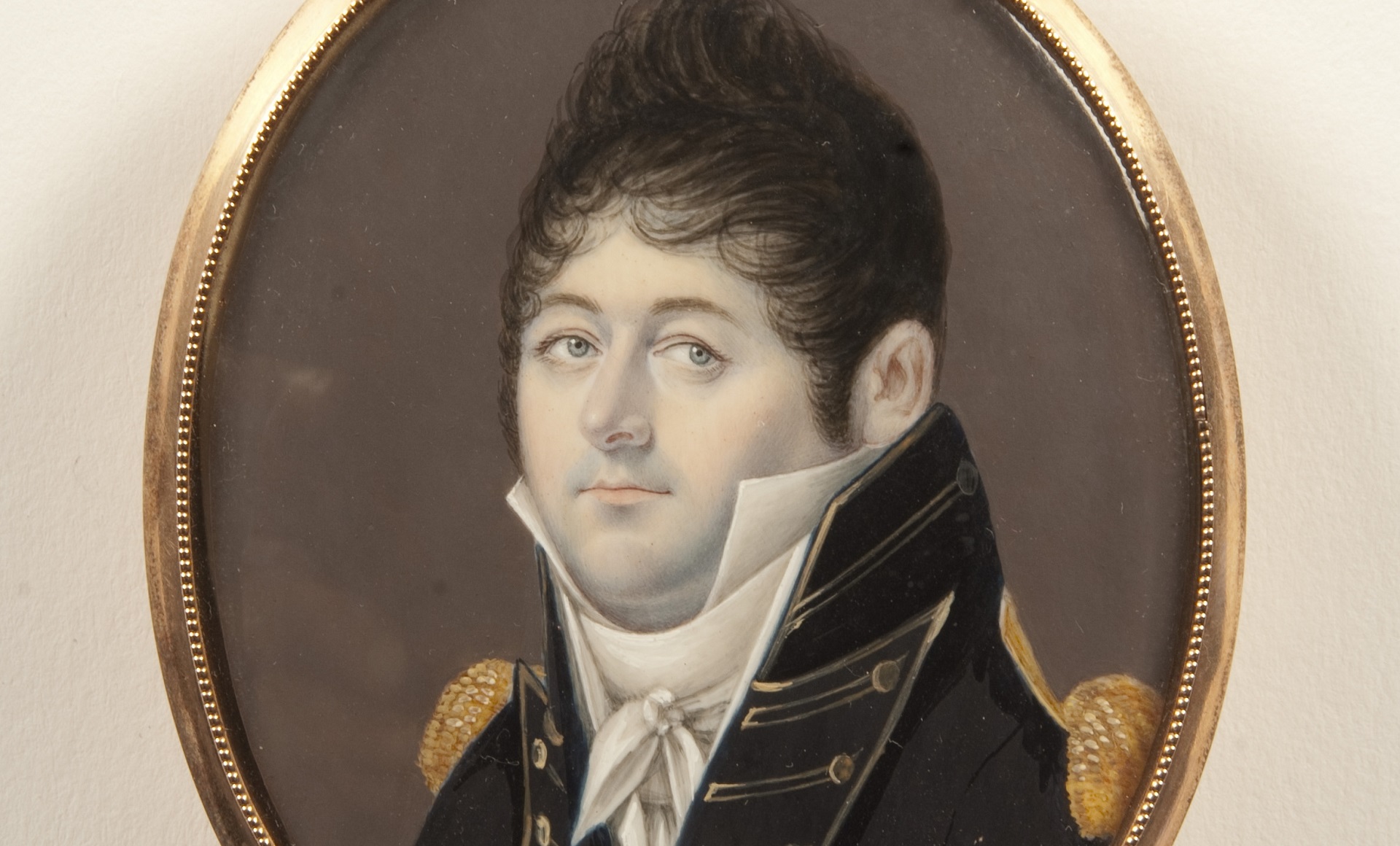A young Isaac Hull glances sideways from a tiny portrait framed in gold. While his expression is nonchalant, his full-dress naval captain’s uniform and stylish coiffure exude an air of prestige. A braided lock of brunette hair is encased on the back.
At only three inches tall, this miniature portrait of Captain Isaac Hull, on loan to the USS Constitution Museum from a private collection, does not carry the gravitas of the massive formal oil portraits of USS Constitution’s captains. But all portraits are windows into the lives of their subjects, and this tiny keepsake is no different.
With limited information on the miniature portrait’s provenance, we set out to learn more and perhaps uncover the portrait’s intended recipient. Through our research, we delved into Isaac Hull’s family history and the tradition of miniature portraiture in the pre-photography era.


Miniature portraits were common mementos and keepsakes in the 18th and 19th centuries. Some were used to commemorate significant life occasions such as births, engagements, and marriages, while others served as signs of friendship or romance. Isaac Hull’s portrait is encased in a frame designed to be used as a piece of jewelry.
Among sailors and officers of financial means, miniature portraits were given to family and close friends as a memento to remember them by while they were away at sea. Depending on the sailor’s budget, miniature portraits could range from simple silhouettes to detailed oil paintings on ivory embellished with jewels and pearls. Though not jewel-encrusted, Isaac’s miniature portrait was painted by a skilled artist using oil on ivory in a rose gold frame.
The encased lock of hair on the back of the portrait’s tiny frame represents another form of honoring or remembering someone. A lock of hair allowed people to literally hold an intimate, tangible piece of their loved ones, so these keepsakes were often used to remember someone during long periods of separation or following a death. As with portraits, giving a lock of hair was a common practice among sailors who would be away from home for a long time. Locks of hair do not decompose quickly and can be woven into braids and incorporated into jewelry. Like portraits, hair mementos and jewelry could range from simple locks tied with a ribbon to intricate woven displays. Isaac’s lock is a relatively simple braided piece.


Isaac Hull’s miniature portrait is clearly a personal piece. So, who was the recipient? Much of the artifact’s provenance remains unknown, including the artist and date, but our research presents some clues.
An obvious candidate is his wife, Ann McCurdy Hart, whom Isaac met in 1812 and married a year later. However, the portrait may have been painted as early as 1806. The two epaulets on Isaac’s uniform identify him as a captain, a promotion he received in 1806. Was the portrait commissioned to celebrate his promotion? Or did he gift it to a family member or romantic interest prior to meeting his future wife?
In Isaac Hull’s biography, The Captain from Connecticut, author Linda Maloney explores several of Isaac’s early love interests. In correspondence with family and friends in 1809 and 1810, Isaac mentions a love interest referred to only as “Miss J.” In a letter to his friend William Bainbridge in December 1809, Isaac bemoaned his lack of money, claiming it was holding him back from marriage.1 In March 1810, he wrote to his stepsister, Mary Wheeler, that Miss J. had departed for Europe with plans to stay there for two years or more.2 He never mentions her again.
When not at sea, Isaac was a regular presence at social occasions. Rumors circulated about his marriage prospects, but there is no record of active love interests. At one time word spread that he was courting Maria Mayo, a friend of Dolley Madison’s. However, Isaac refuted those rumors in a letter to Lieutenant Theodore Hunt: “I have called now and then but not often, so that, my friend, I fear you will never see her Mrs. H”.3
It’s unlikely a love interest was the recipient of Isaac’s miniature portrait. In fact, mention of the memento does not appear in the extant written record of Isaac’s life until after his marriage to Ann McCurdy Hart. Even then, Ann was not the recipient. Rather, Hull’s stepsister Mary Wheeler, is the likely recipient. Mary was a close confidant of Hull’s and he exchanged many letters with her revealing details of his love life.
In a letter to Mary in 1813, the newly married Ann Hull wrote, “I am glad you have my husband’s miniature. When you look at that I suppose I shall get a thought, too, as we are one now… I will promise not to be jealous for it is not captivating enough to steal anyone’s heart.”4
Mary Wheeler’s mother and Isaac Hull’s father married in 1804 when Mary was 13 and Isaac was 31. Isaac’s mother, Sarah Bennett Hull, had died in 1803, leaving behind her husband and seven sons. Though 18 years older and off serving in the Navy, Isaac became close with Mary, and the two regularly exchanged letters in which they shared life’s triumphs and disappointments. Much of their correspondence is held in a collection of papers on loan to the USS Constitution Museum from a private collection and available digitally via Digital Commonwealth.
In 1811, Mary married Isaac’s brother, Levi Hull, in Connecticut. While we can’t say for certain that Isaac’s miniature portrait was intended for Mary, it is clear that she owned it as of 1813. Isaac and Ann remained close with Mary and corresponded regularly throughout their lives.
1 Isaac Hull to William Bainbridge, December 31, 1809, as quoted in Linda Maloney, The Captain from Connecticut: The Life and Naval Times of Isaac Hull (Northeastern University Press, 1986): 134.
2 Isaac Hull to Mary Wheeler, Boston, March 21, 1810. Isaac Hull Papers, USS Constitution Museum on loan from a private collection.
3 Isaac Hull to Theodore Hunt, December 2, 1812, as quoted in Linda Maloney, The Captain from Connecticut: The Life and Naval Times of Isaac Hull (Northeastern University Press, 1986): 203.
4 Ann McCurdy Hart Hull to Mary Wheeler Hull, February 27, 1813. Isaac Hull Papers, USS Constitution Museum on loan from a private collection.
The Author(s)
Susan Reed
Senior Interpretation & Visitor Services Representative, USS Constitution Museum
Susan works in visitor services and education at the USS Constitution Museum.
Carl Herzog
Public Historian, USS Constitution Museum
Carl Herzog is the Public Historian at the USS Constitution Museum.
